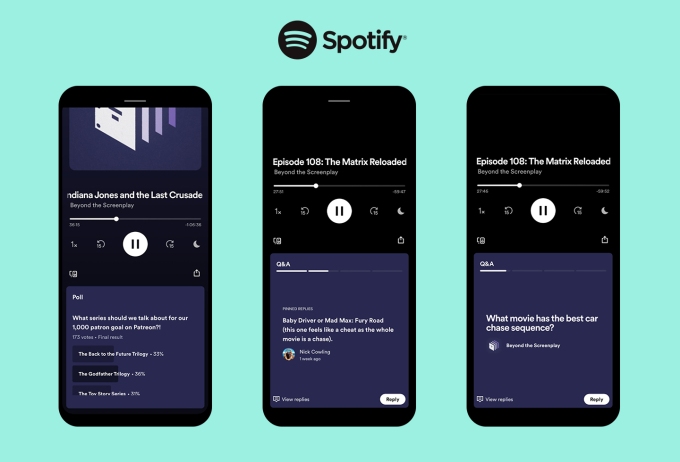Spotify is today introducing is introducing a new ad format aimed at podcasters which it’s calling “Call-to-Action Cards” — or CTA cards, for short. The feature, which is powered by Spotify’s streaming ad insertion technology, will display a visual ad in the Spotify app when the audio ad begins to play. The cards can be customized by advertisers with their own images, text and other clickable buttons that direct listeners to “shop now” or take some other action the advertiser is hoping to encourage.
While the ads are capable of capturing users’ attention while streaming, Spotify knows that listening to podcasts is often an activity where the app is running in the background while the user is doing something else — like going for a walk, exercising at the gym, doing housework, driving and more. That’s why Spotify is also making the new CTA cards available on both the podcast’s show and episode pages. This allows the targeted listeners to interact with the ad at some later point when they’re browsing through the Spotify app, the company explains. These cards will remain available for up to seven days after the listener has heard the ad, or less if the campaign wraps before that.

Image Credits: Spotify
In the future, Spotify believes the format will evolve to do more than simply directing users to a landing page of some kind.
“We think about these cards as an important step towards modernizing the format — a format that will become more capable over time, as we add shoppable and video and other interactive features into them,” said Jay Richman, Spotify’s Head of Ads Business & Platform, when introducing the format during a press briefing as a part of the company’s virtual participation at this week’s Consumer Electronics Show.
Advertisers who adopt the format will also have access to reporting and measurement based on confirmed ad impressions made possible through streaming ad insertion.
Spotify has heavily invested in the streaming ad insertion technology, which brought real-time targeting and reporting to podcasts. Before, when podcasts were delivered through the more open RSS format, they were also hampered by the technical limitations that came with being downloadable content only. Ads were embedded, not dynamically inserted, into shows. And the audio players couldn’t differentiate between which part of the program was the show’s content and which part was the ad — it was all one single file. With streaming audio insertion, the content itself is paused, the ad is inserted, and then the content resumes after the ad completes.
All of this takes place in real-time — but it doesn’t prevent the listener from skipping past the ads as they had before, if they don’t enjoy hearing the message.
In 2020, Spotify acquired the podcast hosting and ad company Megaphone for $235 million to help scale streaming ad insertion beyond its own shows to reach publishing partners through the Spotify Audience Network — a network that now includes shows from independent creators using Spotify’s Anchor platform. And just last month, Spotify acquired podcast tech company Whooshkaa to bring the technology to radio broadcasters who want to release their audio content as podcasts after first airing it on the radio.

Image Credits: Spotify
Because streaming ad insertion already knows when the ad appears in the program, Spotify can then pop up the accompanying CTA card as well to display the advertiser’s creative. For listeners, the experience may be a better one for seeking out the products and services they heard the host promoting during the program, as they’ll no longer have to try to remember a URL or a coupon code the creator had spoken.
However, the addition also makes using Spotify to stream podcasts feel even more like an ad-supported experience than before, as even Premium (paying) subscribers will be subject to the new, arguably distracting ads and will see them appear on both podcast show and episode pages even after they’ve finished listening.
Spotify tested the new CTA cards with select advertisers, including Ulta Beauty, ahead of today’s launch. According to Ulta’s Head of Content, Social, & Integrated Marketing, Christine White, the company reached around 250,000 unique Spotify listeners with one of its campaigns and around half of those saw at least one CTA card after hearing the audio message, including those who saw the card later while browsing the app.

Image Credits: Spotify
Spotify sees the CTA cards as another step toward making podcast content more interactive. The company is already experimenting in this area through features like voice commands and podcast audience polls and Q&As, which engage listeners in real-time — making them more likely to return to the app while the podcast is playing, too. More recently, it’s been expanding access to video podcasts, via Spotify’s Anchor platform. Podcaster creators can add a video to their podcast to show themselves recording the show or they can use the functionality to add the occasional graphic, chart, or slide. This feature is now rolling out to more creators and listeners, said Anchor co-founder and Spotify’s Head of Talk, Mike Mignano, during the same briefing.
Spotify notes that no incremental work will be required by creators to enable the new CTA cards, which will initially be available across select Spotify Original & Exclusive podcasts in the U.S., starting today.


